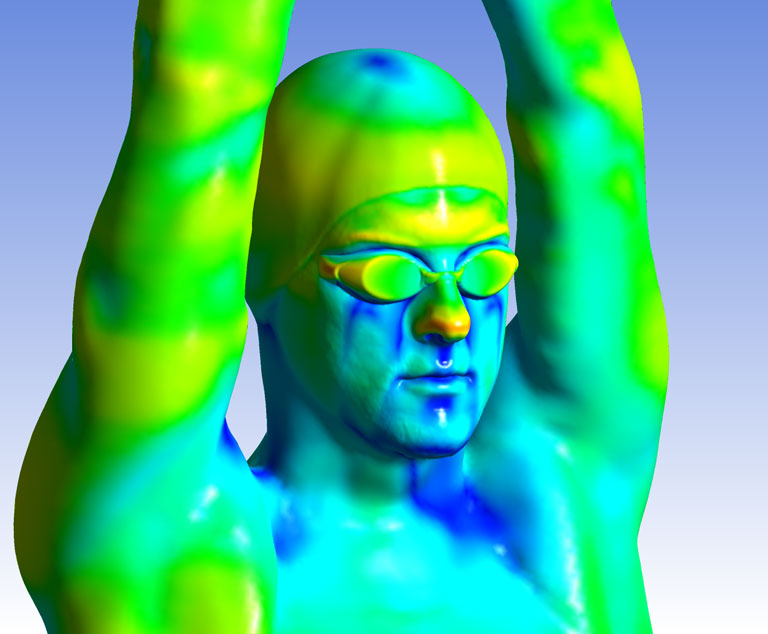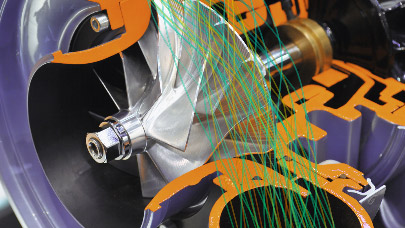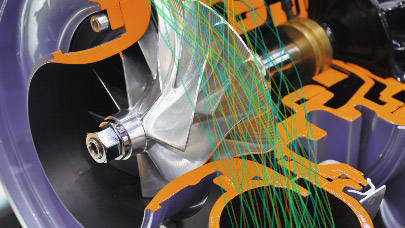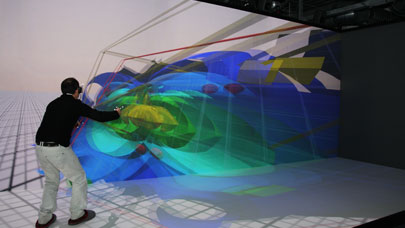Turbulence Models for Complex Flows
Turbulence modeling makes it possible to account for turbulence effects using CFD at a reasonable computational cost. No single model or modeling approach can cover all types of turbulent flow, so different types of turbulence models have been developed in the past decades. For combustion, acoustics and other similar applications, some of the turbulent structure needs to be resolved to ensure accurate results.
Steady-State Models – Steady-state or Reynolds-averaged Navier–Stokes (RANS) models reduce the complexity of modeling turbulent flows by averaging the velocity field, pressure, density and temperature over time. The steady-state approach calculates mean flow quantities, and no attempt is made to resolve turbulent structures in time and space. Therefore, RANS methods are computationally frugal. If selected and applied properly, the models offer engineers a highly attractive solution to predict the effect of turbulence without having to explicitly capture all scales involved in turbulent flows. RANS techniques are very accurate for the vast majority of applications. However, for some applications, more advanced models that resolve some of the turbulence scales are required.
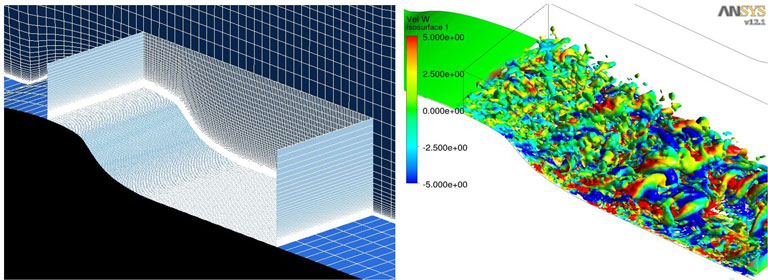
Software development experts at ANSYS recently progressed the state of the art with two advanced hybrid models: wall-modeled LES (WMLES) and embedded LES (ELES) turbulence models. WMLES allows the simulation of wall-bounded flows without the excessive computational costs associated with classical LES modeling. The ELES model offers even more flexibility by allowing an embedded LES zone within a larger RANS-simulated steady-state domain. This results in accurate simulation without excessive computational expense. This image shows turbulence structures created in the wake of a Volvo bluff body flame holder. Results were obtained using the detached delayed eddy simulation.
Large-Eddy Simulation and Hybrid Models – Large-eddy simulation (LES) turbulence models resolve the large turbulent structure in both time and space and simulate only the influence of the smallest, non-resolved turbulence structures. These models are usually one or two orders of magnitude more computationally expensive than the RANS approach, especially for complex industrial applications. As turbulent structures become very small in the near-wall region, the associated computational resources needed would make it too expensive and time consuming to use in the product development process. This poses severe challenges for LES simulations of applications in which wall effects impact product/design performance. The solution to this problem is hybrid models, such as detached-eddy simulation (DES) and scale-adaptive simulation (SAS) models that combine steady-state and LES treatments for the model’s wall boundary layer and free shear portions, respectively.
Transition models – The flow around turbine blades, wings and many other applications often features upstream laminar boundary layers that transition into a turbulent flow further downstream. Capturing this phenomenon is key to predicting wing lift or compressor performance, for example. To aid in analyzing this widely observed physical behavior, a new class of models predict behavior of a flow over a surface that starts in the laminar regime and transitions to the turbulent regime. Turbulence transition models significantly expand the range of applications for CFD software.
Conclusion
Turbulence is inherent to most flow problems and is usually the major limiting factor in accurate simulation. No single model or modeling approach can cover all types of turbulent flow, so different types of turbulence models have been developed in the past decades. As CFD applications become more complex, more sophisticated turbulence models are needed. Choosing the right turbulence model to match the application is critical to accuracy and computational resource optimization.
Speedo: complex models for competitive hydrodynamics
In Olympic swimming competitions, the difference between gold and silver medals can be mere milliseconds, so tiny improvements to multiple details can be critical. Legendary swimsuit manufacturer Speedo is using CFD to remove swimwear imperfections that increase drag while the athlete is swimming. Speedo Aqualab engineers studied three key elements of the gear: swimsuit, goggles and cap. The combination of flow around these elements and the athlete’s body features creates an extremely complex and turbulent environment. Hence, very accurate turbulence models are needed to predict which design will create the least resistance in the water and which design will give a competitive edge to the swimmer, even before the race starts.
For the most recent world-class races, the engineering team focused on improving the hydrodynamics of goggles, cap and suit. The innovative suit precisely fits the athlete’s body and reduces drag. The cap reduces significant flow-field disruptions leading to improved performance. The goggle design blends with the athlete’s facial features and results in minimum flow disruptions. Performance gains were real: for example, the goggle’s CFD simulation- led design resulted in a performance improvement of 2 percent. When added to improvements that come from the suit and cap as well, this innovative swimwear system can enable an athlete to reduce race time by milliseconds, enough to turn a silver medal into gold. According to Dr. Tom Waller from Speedo Aqualab, “Engineering simulation has been absolutely critical in launching this world-first concept.”
More around this topic...
In the same section
© HPC Today 2024 - All rights reserved.
Thank you for reading HPC Today.

